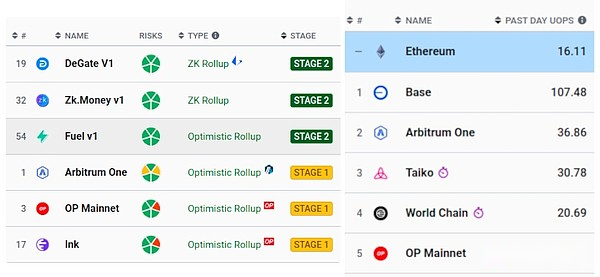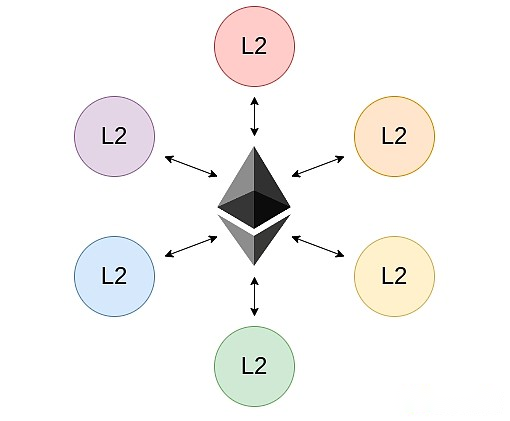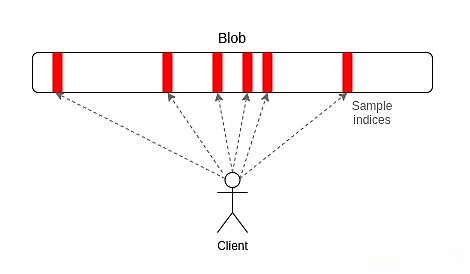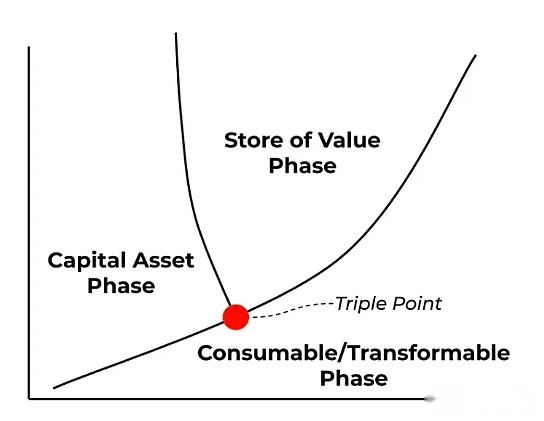
Original title:Scaling Ethereum L1 and L2s in 2025 and beyond
Author: Vitalik, founder of Ethereum; compiled by: Baishui, Bitchain Vision
Ethereum’s goal is the same as it started on day one: to build a global, censored, and permissionless blockchain.A free open platform for decentralized applications built on the same principles as GNU+Linux, Mozilla, Tor, Wikipedia and many other great free open source software projects before (which we can call today regen and passwordsabove the punk spirit).
Over the past decade, Ethereum has developed another feature that I really appreciate: In addition to innovations in cryptography and economics, Ethereum is also an innovation in social technology.As an ecosystem, Ethereum is an effective and live demonstration of a new, more open and decentralized way of building.Political philosopher Ahmed Gatnash describes his experience at Devcon this way:
…A glimpse into what another world might look like—a world with little to no gatekeeper, a world without legacy systems.In the subversion of the social standard status system, the people with the highest social status are nerds who spend all their time focusing on independently solving problems they really care about, rather than playing games to climb to the level of legacy institutionssystem and accumulate power.Almost all power here is soft power.I think it’s beautiful and inspiring – it makes you feel like everything is possible in such a world that is actually within reach.
Technical and social projects are essentially intertwined.If you have a decentralized technical system at time T but have a centralized social process to maintain it, then there is no guarantee that your technical system will still be decentralized at time T+1.Similarly, social processes remain vibrant in many ways through technology: technology brings users, and the ecosystem formed by technology provides incentives for developers to come and stay, which keeps the community solid and focused on building rather than just socializing,etc.

You can use Ethereum to pay around the world, October 2024.
After ten years of hard work, Ethereum embodies another important quality under this mix of technological and social attributes:Ethereum does useful things for people on a large scale.Millions of people hold ETH or stablecoins as a form of savings, and many more use these assets to pay: I am one of them.It has effective, practical privacy tools that I use to pay for VPNs to protect my internet data.It has ENS, a powerful alternative to decentralized DNS and, more generally, a public key infrastructure.It has practical and easy to use Twitter alternatives.It has defi tools that provide millions of people with lower risk assets that are higher than what they can earn in traditional finance.
Five years ago, I was reluctant to talk about the latter use case, mainly because the infrastructure and code are immature, only a few years after the massive and extremely traumatic smart contract hacking in 2016-17, if every yearThere is a 5% chance to get -100% APY, then 7% APY instead of 5% APY is meaningless.Besides that, the transaction fee is too high to make these things use on a large scale.Today, these tools have shown their resilience over time, the quality of audit tools has improved, and we are becoming more confident in their security.We know what not to do.L2 extension is working.Transaction fees have been very low in the past year.
We need to continue to build the technical and social attributes and practicality of Ethereum.If we have the former but without the latter, then we will degenerate into an increasingly ineffective “decel” community that can roar towards the wind and say that all kinds of mainstream actors are immoral and bad, butThere is no stance that really offers a better option.If we have the latter, but without the former, then we have the mentality of Wall Street greed is a good one, and many of us come here to escape this mentality.
The duality I just described has many meanings.In this post, I want to focus on a specific one, which is very important for short- and medium-term users of Ethereum:Ethereum’s scaling strategy.
The rise of L2
Today, our approach to expanding Ethereum is the Layer 2 protocol (L2s).L2s in 2025 are far from the early experiments in 2019: they have reached critical decentralization milestones, they are ensuring billions of dollars in value, and they are currently expanding Ethereum’s transaction capacity by 17 times, feesA similar magnitude has been reduced.

Left: Phase 1 and Phase 2 Rollup.On January 22, Ink became the sixth Stage 1+ Rollup (and the third complete EVM Stage 1+ Summary).The picture on the right is Rollup, ranked high by TPS, with Base leading, accounting for about 40% of Ethereum capacity.
It all coincides with the wave of successful applications: various DeFi platforms, social networks, forecast markets, and strange devices like Worldchain (now with 10 million users).After the failure of alliance blockchain in the 2010s, the “enterprise blockchain” movement was widely regarded as a dead end, but with the emergence of L2s, this movement revived, and Soneium is a classic example.
These successes also prove the sociality of Ethereum’s decentralized and modular scaling approach: instead of finding all of these users themselves, the Ethereum Foundation has dozens of independent entities that are motivated to do so.These entities have also made important contributions to the technology, and without which Ethereum would not have evolved as it is today.So we finally approached the escape speed.
Challenge: Size and deal with heterogeneity
Currently, L2 faces two main challenges:
-
scale:Our blob spaces are hardly able to cover L2 and today’s use cases and are far from meeting future needs.
-
Heterogeneity Challenge:The early vision of how Ethereum can scale involves creating blockchains containing many shards, each of which is a copy of the EVM processed by a small number of nodes.In theory, L2 is the implementation of this approach.However, in practice, there is a key difference: each shard (or shard set) is created by different actors, treated as different chains by the infrastructure, and generally follows different criteria.Today, this translates into a composability and user experience issue for developers and users.
The first problem is an easy-to-understand technical challenge, and there is an easy-to-describe (but difficult to implement) technical solution: provide more blobs for Ethereum.In addition, L1 can be moderately expanded in the short term, as well as improvements in proof of stake, stateless and lightweight verification, storage, EVM and encryption technologies.
The second issue has attracted widespread public attention and is the issue of coordination.Ethereum is no stranger to performing complex technical tasks between multiple teams: after all, we merged.Here, coordination issues are more challenging because there are more numbers and diversity of participants and goals, and the process begins later in the game.But even so, our ecosystem has solved the puzzle before and we can do it again.

A possible shortcut to extension is to abandon L2 and do everything with L1 with higher gas limits (spanning multiple shards or on one shard).However,This approach hurts most of the benefits of Ethereum’s current social structure, which is very effective in simultaneously obtaining the benefits of different forms of research, development and ecosystem building cultures.So we should stick with it and continue to expand primarily through L2, but make sure that L2 does fulfill the promises they should fulfill.
This means the following:
-
L1 NeedAccelerate the expansion of blobs.
-
L1 also needsModerately expand EVM and increase gas limits, in order to be able to handle activities that will continue even in the L2-dominated world (such as proof, large-scale defi, deposits and withdrawals, special mass exit scenarios, keystore wallets, asset issuance).
-
L2 NeedContinue to improve safety.The same security guarantees that one expects to be obtained from shards (including, for example, censorship resistance, light client verifiability, lack of fixed trusted parties) should be available on L2.
-
L2 and wallet needAccelerate improvements and standardize interoperability.This includes chain-specific addresses, messaging and bridging standards, efficient cross-chain payments, on-chain configurations, and more.Using Ethereum should feel like using an ecosystem, not 34 different blockchains.
-
L2Deposit and withdrawal time needs to get faster.
-
As long as basic interoperability needs are met,L2 heterogeneity is good.Some L2s will be based on governance minimization Rollup, running an exact copy of the L1 EVM.Others will try to use a different VM.Others will be more like using Ethereum to provide additional security for users.We need to have L2 in every part of that spectrum.
-
We should consider it clearlyEconomics of ETH.We need to ensure that ETH continues to accumulate value even in the heavy world of L2, ideally solving various models of value accumulation.
Now let’s discuss each topic area in more detail.
blobs, blobs, blobs

With EIP-4844, we now have 3 blobs per slot, or each slot has a data bandwidth of 384 kB.The quick calculation shows that this is 32 kB per second, and each transaction takes about 150 bytes on the chain, so we get ~210 tx/sec.The L2beat data almost gives this number exactly.
For the Pectra, which is scheduled to be released in March, we plan to double it to 6 blobs per slot.
Fusaka’s current goal is to focus primarily on PeerDAS, ideally nothing but PeerDAS and EOF.PeerDAS can increase the number of blobs by another 2-3 times.
After that, the goal is to keep increasing the number of blobs over time.When we do 2D sampling, we can reach 128 blobs per slot and continue to move forward.With this, and improvements in data compression, we can reach 100,000 TPS on-chain.
So far, the above is a re-statement of the current status roadmap before 2025.The key question is: What changes can we actually make to speed up this process?My answer is as follows:
-
We should be more willing to explicitly reduce the priorities of non-blob functions.
-
We should know more clearly that blobs are the target and make relevant p2p R&D a priority in talent acquisition.
-
We can let the staker adjust the blob target directly, similar to gas restrictions.This will allow blob targets to increase faster in response to technological improvements without waiting for hard forks.
-
We can consider more radical approaches that allow us to get more blobs faster and provide more trust assumptions for stakers with less resources, but we should be cautious about this.
Improve security: Proof system and native Rollup
Today, there are three first-stage Rollups (Optimism, Arbitrum, Ink) and three second-stage Rollups (DeGate, zk.money, Fuel).Most activities still occur on stage 0 Rollup (i.e., multi-signature).This situation needs to be changed.One important reason this situation doesn’t change faster is that it’s difficult to build a proof system and have enough confidence in it to give up the training wheel and rely entirely on it to ensure safety.
There are two ways to achieve this:
-
Phase 2 + Multi-Proof + Formal Verification:Use multiple proof systems to achieve redundancy and ensure its security using formal verification (see: Verified ZK-EVM Program).
-
Native Rollup:Use EVM state transition function verification as part of the protocol itself, for example by precompilation (see: [1] [2] [3] for research).
Today, we should do both tasks at the same time.For Phase 2 + Multi-Proofer + Formal Verification, the roadmap is relatively easy to understand.The main practical area we can accelerate is to collaborate more on the software stack, reducing the need for duplicate work, while increasing interoperability.
Native Rollup is still an early idea.There is a lot of positive thinking to do, especially on the topic of how to make native aggregate precompilation the most flexible.An ideal goal is to make it support not only the exact cloning of the EVM, but also the EVM with various arbitrary changes, so that L2 with modified EVM can still be precompiled using native aggregation and brings its own proof only for modification.”.This can be used for precompilation, opcodes, state trees, and possibly other parts.
Interoperability and standards
Our goal is to experience the same when they are different “slices” of the same blockchain when moving assets and using applications between different L2s.For months, there has been a fairly easy-to-understand roadmap on how to do this:
-
Link-specific address:The address should include the account on the chain and some identifier of the chain itself.ERC-3770 was an early attempt in this regard, and now there are more complex ideas, they also moved the registry of L2 to Ethereum L1 itself.
-
Standardized cross-chain bridge and cross-chain messaging:There should be standard ways to verify proofs and pass messages between L2, and these standards should not require trust in anything other than the proof system of L2 itself.An ecosystem that relies on multi-signature bridges is unacceptable.If this is a trust assumption, if we did the 2016 style sharding, it wouldn’t exist, then today it’s unacceptable.
-
Speed up deposit and withdrawal times so that “native” messages can be completed in minutes (finally a slot) rather than in weeks.This involves faster ZK-EVM prover and proof aggregation.
-
Read L1 synchronously from L2.See: L1SLOAD, REMOTESTATICCALL.This makes cross-L2 interoperability easier and also helps with keystore wallets.
-
Share sorting and other long-term work.The value based on summary is that they may be able to do this more effectively.
As long as these criteria are met, L2 still has a lot of room to have very different properties: try different virtual machines, different sorting models, scale and security tradeoffs, and other differences.However, users and application developers must be clear about the level of security they are getting.
To make faster progress, most of the work can be done by entities operating across ecosystems: the Ethereum Foundation, client development teams, major application teams, and more.This will reduce coordination efforts and make adopting standards a little easier, as each individual L2 and wallet will do less work.However, as an extension of Ethereum, L2 and wallets still need to step up the last mile work of actually implementing these features and bringing them to users.
Economics of ETH

ETH as a three-phase asset
We should adopt a multi-pronged strategy to cover ETH as all the main possible sources of value for three-phase assets.Some key contents of this strategy are as follows:
-
Broadly agreed to consolidate ETH into a major asset in the larger (L1 + L2) Ethereum economy, supports applications that use ETH as the main collateral, etc.
-
Encourage L2 to support ETH through a certain percentage of fees.This can be achieved by destroying a portion of the expenses, pledging permanently and donating the proceeds to public products of the Ethereum ecosystem or some other solution.
-
Partially support rollup based on rollup as a way for L1 to obtain value through MEV, but don’t try to force all rollups to be based on this (because it doesn’t work for all applications), and don’t think that just that will solve the problem.
-
Increase the number of blobs, consider the lowest blob price, and treat blobs as another possible source of income.As a possible future example, if you take the average blob fee over the past 30 days and assume that it remains the same (due to inducing demand) and the blob count increases to 128, Ethereum will destroy 713,000 ETH per year.However, this favorable demand curve cannot be guaranteed, so don’t think that this alone can solve the problem.
Summarize:The road to the future
Ethereum has matured as a technology stack and social ecosystem, bringing us closer to a more free and open future where hundreds of millions of people can benefit from crypto assets and decentralized applications.However, there is still a lot of work to be done, and now is the time to double down on your efforts.
If you are an L2 developer, contribute to the tools, make the blobs more securely, contribute to the code, extend the execution of EVMs, and contribute to the capabilities and standards that make L2 interoperable.
If you are a wallet developer, you also need to participate in contributing and implementing standards to make the ecosystem more seamless to users, while being as secure and decentralized as Ethereum is just L1.
If you are an ETH holder or a member of the community, be actively involved in these discussions; many areas still require active thinking and brainstorming.
The future of Ethereum depends on the active participation of each of us.
This article is particularly grateful to Tim Beiko, Justin Drake, and developers from various L2 teams for their feedback and review.








